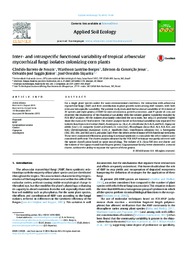Inter- and intraspecific functional variability of tropical arbuscularmycorrhizal fungi isolates colonizing corn plants.
Inter- and intraspecific functional variability of tropical arbuscularmycorrhizal fungi isolates colonizing corn plants.
Autoria: NOVAIS, C. B. de; BORGES, W. L.; JESUS, E. da C.; SAGGIN JUNIOR, O. J.; SIQUEIRA, J. O.
Resumo: For a single plant species under the same environmental conditions, the interaction with arbuscularmycorrhizal fungi (AMF) and their contribution to plant growth varies among AMF isolates, with bothinter and intraspecific variability. The present study evaluated the functional variability of 41 isolates of20 species and eight genera of AMF for root colonization, growth promotion, and P uptake of corn andobserved the relationship of this functional variability with the isolates genetic variability revealed byPCR-RFLP analysis. All the isolates abundantly colonized the corn roots, but only 23 promoted highershoot dry mass and P leaf content. The cluster analysis based on functional variability data separated theisolates Acaulospora morrowiae (Am2), Acaulospora sp. (Aca), A. colombiana (Ac3, Ac4, and Ac5), Gigasporaalbida (Gia1), Gi. margarita (Gim4 and Gim5), Gi. rosea (Gir), Rhizophagus clarus (Rc2, Rc3, Rc4, Rc5, andRc6), Claroideoglomus etunicatum (Ce4), R. manihotis (Rm), Scutellospora calospora (Sc), S. heterogama(Sh2, Sh3, Sh4, and Sh5) and S. pellucida (Sp3) from the others at the distance of 80% functional similarity.These were considered efficient in promoting functional symbiosis in corn while the other isolates wereconsidered inefficient. The cluster analysis obtained by the PCR-RFLP technique was partly coherent withthe species classification based on spore morphology. The isolates of R. clarus fell into one cluster andthe isolates of the Gigaspora and Scutellospora genera (Gigasporaceae family) were clustered in a secondcluster, without the ability to separate the species of these genera.
Ano de publicação: 2014
Tipo de publicação: Artigo de periódico
Unidade: Embrapa Amapa
Palavras-chave: Acaulospora, Geographical isolates, Gigaspora, Glomus, RFLP
Observações
1 - Por padrão são exibidas publicações dos últimos 20 anos. Para encontrar publicações mais antigas, configure o filtro ano de publicação, colocando o ano a partir do qual você deseja encontrar publicações. O filtro está na coluna da esquerda na busca acima.
2 - Para ler algumas publicações da Embrapa (apenas as que estão em formato ePub), é necessário ter, no celular ou computador, um desses softwares gratuitos. Sistemas Android: Google Play Livros; IOS: iBooks; Windows e Linux: software Calibre.
Acesse outras publicações
Acesse a Base de Dados da Pesquisa Agropecuária (BDPA) para consultar o acervo completo das bibliotecas da Embrapa.

